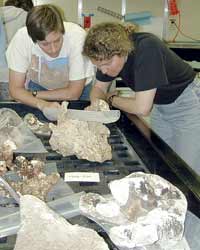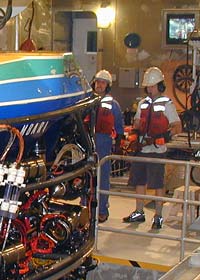Juli Morgan
Juli Morgan is a modern-day explorer. A geophysicist at Rice University, she has sailed on nine “research cruises” on specially designed ships to distant parts of the world, where she studies one of Earth's last unexplored territories: the bottom of the ocean. “What is most exciting about going on a cruise is being able to explore a part of the world that's never been seen before,” she said.

Morgan and her colleague Jenny Paduan look at coral samples recovered by MBARI's ROV Tiburon off the coast of the Big Island of Hawaiì.

MBARI's remotely operated vehicle (ROV) Tiburon is recovered after a successful dive off the coast of the Big Island of Hawaiì.
In some ways, scientists know more about the surface of the moon than about the bottom of the ocean. Marine geophysicists add to that knowledge in several ways. Morgan and her colleagues tow air guns behind their ships; these guns shoot pressurized air into the water below, which creates a sound wave that passes through the water into the rocks beneath. The wave reflects off boundaries between rock layers, and the reflected waves travel back up through the rocks and water to the ship. By analyzing when the waves return to the ship, Morgan can learn about the depths and compositions of layers below the ocean floor. “The contribution I'm able to make is interpreting the subsurface,” she said.
Morgan has gone on cruises off the coasts of Japan, the Philippines, Portugal, and Hawaiì. In Hawaiì, she studies giant landslides that fell off volcanoes on the islands. One of the largest landslides happened about one million years ago, when one-third of Oahu's Koolau volcano suddenly slid into the ocean. Today, scientists still see evidence of this disaster, as blocks of debris as large as 30 kilometers (19 miles) across and 1-2 kilometers (0.6-1.2 miles) high lie as far as 100 kilometers (62 miles) offshore. Although no record exists, the landslide must have spawned a tsunami, or giant wave, that traveled all the way across the Pacific. By understanding how landslides happen, Morgan hopes to predict what kinds of tsunamis and related coastal damage the landslides will cause.
Morgan grew up in the Hudson valley, about an hour north of New York City. “I grew up on a geologic uplift,” she said — a part of the crust that has been pushed up by tectonic forces in the Earth. Her parents were physicists and mountain climbers, and she was interested in rocks as a child, but she did not expect to study geophysics. After graduating from high school, she took a few years off and got a job driving a van. “While I was driving the van,” she said, “it gave me time to learn what I wanted to learn.” She took an earth science course at a local community college and fell in love with geology. She went to college and graduate school, then held several geophysics research positions at universities. She began her research into landslides as an assistant researcher at the University of Hawaiì. “Living in Hawaiì was an excellent experience,” she said. “There is so much to do and learn in the islands.”
While in Hawaiì, Morgan learned to play the ukulele and paddle traditional Hawaiian outrigger canoes. “[Paddling] was a wonderful release,” she said. “It was a wonderful way to see the islands.” She started her job at Rice in summer 1999, but stayed in Hawaiì for two more months to go on a Japanese research cruise around the islands. On the cruise, she had the opportunity to dive 5000 meters (3.1 miles) to the ocean floor in the deep diving submersible Shinkai 6500 to collect rocks from an active submarine landslide. Since arriving at Rice, she had to give up outrigger canoe paddling. “The ocean is an hour away [from Houston],” she said. “The drive was too much.” But she still plays the ukulele regularly.











